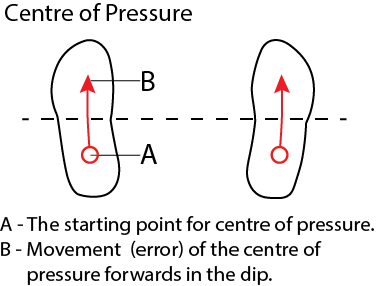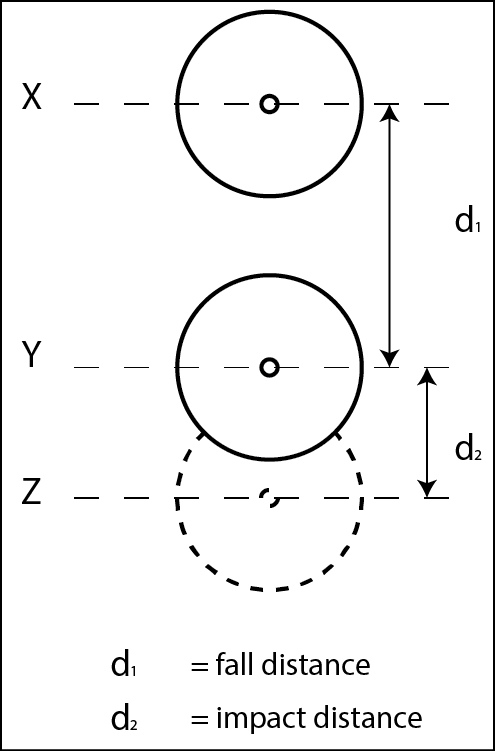The Dip Phase of the Jerk
Elevation of the Bar
For a successful lift, the Dip and Drive phase of the Jerk must elevate the bar sufficiently to give the athlete time and space to drop into the receiving position and lockout. It is interesting to note, however, that in High Performance lifting it is probable that the bar rises surprisingly little as a result of the dip. In the illustration that follows, a male lifter weighing 77Kg, lowers the bar in the dip by 18 cm before raising it 32 cm from the bottom of the dip. The bar height gain is therefore 14 cm and a comparison between the first and last positions shows that the maximum elevation of the bar may not even reach the top the head.

Control of Force Direction
Elevation of the bar in the dip phase of the Jerk should be in one direction only – vertically upwards. This directional control requires an absolute avoidance of any rotation of the upper body during the dip, in other words the body must stay totally vertical. If the athlete rotates forward as shown in illustration below, the bar will gain horizontal movement and momentum that is difficult not impossible to arrest at limit weights.

Centre of Pressure
Another common fault in the jerk is forward movement of the ‘centre of pressure’ during the dip phase of the Jerk. The ‘centre of pressure’ is the effective point of application of force through the foot into the floor. What commonly happens in the Jerk is that as the athlete dips, weight is transferred from the back of the foot to the ball of the foot. This effectively causes forward motion of the athlete and the bar.
To avoid this issue, it is critical for the athlete to ‘bear down’ through the heels in the Dip to prevent the centre of pressure moving forwards.
Velocity in the Dip Phase of the Jerk
The higher the downward velocity of the bar, the greater ‘impact’ of the bar at the bottom of the dip. The impact, that is the abrupt stopping of the bar to reverse its direction, must be absorbed by the body. If the downward velocity of the bar in the dip phase of the Jerk is too great, the athlete is at risk of ‘buckling’ in the torso, that is losing rigidity in the spine. The athlete will often show a partial collapse of the chest and a dropping of the elbows. When this happens, the athlete almost always fails the Jerk.
On the other hand, both the body and the bar acts like a spring at the bottom of the dip, and this provides some assistance in the upward movement of the bar. If the dip is too slow, the athlete risks losing some of the beneficial spring effect. It is important to control the dip velocity. If it is too rapid or too slow, there can negative consequences.
To see how this works mathematically, in the figure below, X is the start of the Dip and Z is the bottom of the Dip. Y is an arbitrary point at which barbell downward velocity begins to slow. The distance between X and Y (marked as the distance d1) is the “fall” distance. This is not a free fall as the athlete is resisting the downward movement of the bar. During the “fall”, the bar will be accelerating. The distance between Y and Z (marked as d2) is the “impact” distance and is characterised by deceleration of the bar until it comes to a stop at Z. During the “impact” distance, the athlete is exerting great force to decelerate the barbell to zero and change its direction to upward.
The following spreadsheet illustrates that the consequence of a more rapid dip during the fall distance (in the Jerk) is that more force is required to decelerate and change the direction of the bar. The difference between Case 1 and Case 2, is that in Case 2 the fall time is 0.25 sec or 25% longer duration than Case 1 which is 0.20 sec. Therefore the downward velocity over the “fall distance” is faster in Case 1 (1.18 m/sec) than in Case 2 (0.944 m/sec). The result of the slow dip speed in Case 2, is that force required to turn the bar around is 717 Newtons, and this is significantly less than the force required in Case 1 (897 Newtons).

There may be a limit to which each athlete can produce sufficient force at the bottom of the Dip without significant “buckling” of the body. The issue is that coaches and athletes are not aware that a fast Dip can be problematic. The incorrect assumption made is that a faster Dip stores more kinetic energy, and therefore a more ballistic Dip and Drive gives the athlete a better chance of elevating the bar to the height needed. However this assumption does not take account of the athlete’s limited ability to avoid “buckling” which causes the kinetic energy to be absorbed in body position changes rather than transmitted to the barbell.



